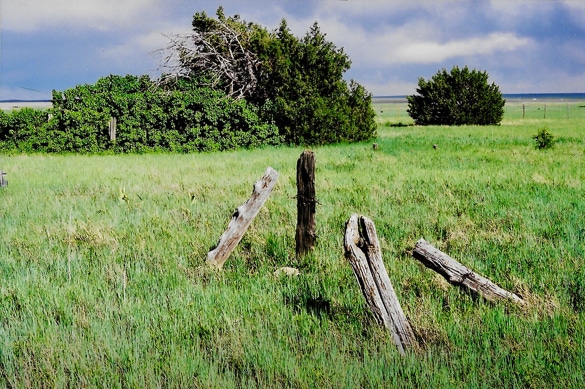
Eastern plains, San Miguel County, New Mexico. Photo by Sharon Snyder
By SHARON SNYDER
Los Alamos Historical Society
When Ashley Pond Jr. founded the Los Alamos Ranch School in 1917, the road from Santa Fe to the school passed through the tiny village of Buckman, situated on the east side of the Rio Grande.
Buckman was a mail stop for the Denver and Rio Grande narrow gauge railroad, and nearby homesteaders and the people from the ranch school crossed a rickety wooden bridge over the river to visit the Buckman post office. The inconvenience prompted A.J. Connell, director of the school, to request a post office. He submitted the ranch name to the postal service, but he soon learned that a town north of Las Vegas, NM, already had the name Los Alamos. He would have to choose another name.
Connell submit three possible names to the U.S. Post Office Department, and, of those three, they selected Otowi. That name was used until the Manhattan Project took over the plateau and Los Alamos mail channeled through P.O. Box 1663 in Santa Fe. In 1946, the Los Alamos Post Office was built and had no trouble claiming the town’s name because the other Los Alamos was long gone, having passed into history on the edge of the prairie in San Miguel County.
Some two decades ago, former historical society archivist Linda Aldrich and I went to San Miguel County to find what might be left of that other Los Alamos. We soon realized that on the edge of the Great Plains, wooden buildings and dirt roads are quickly reclaimed by the land. The area is ranching country just as it was in the late 1800s and early 20th century, so the surrounding terrain is somewhat the same, but the history of the people who lived there is, for the most part, lost in time. Still, old newspapers and government records can give a glimpse of the life of a once thriving town.
Andres Sena, a “dealer in merchandise,” seems to have been a noted citizen of Los Alamos, as he was mentioned in the Las Vegas newspaper quite often. The advertisements for his ranch told readers that he dealt in “Cattle, Sheep, Wool, Hides, Grain, and all kinds of Produce,” along with “freighting to all parts of the Territory.” According to another article, Sena was one of the largest sheep owners in the Territory, claiming more than 5,000 head.
Charles Ilfeld, a noted entrepreneur in early New Mexico, opened a merchandise store in Los Alamos in addition to operating stores in Las Vegas and Tecolote. Ilfeld was one of the most successful businessmen of his time, and the fact that he opened a store in Los Alamos tells something of the town’s growth and success. However, in another news article we learn that “Manuel Gonzales y Baca broke into the post office and was released on his own recognizance after giving valuable evidence concerning others involved.” Some things never change.
A 1911 article notes that 25 men of Los Alamos were listed “as voting for the adoption and passage of the constitution” for the new State of New Mexico. The people of the other Los Alamos lived through some exciting times.
The 1998 Roads of New Mexico atlas marks Los Alamos in San Miguel County, but it is not listed in the index nor does it give the population figure. In Robert Julyan’s Place Names of New Mexico (1996), the “tiny hamlet” is listed as inhabited. A decade later, Linda Aldrich and I found a small chapel and an old cemetery. That’s not to say that over a hill there might not have been someone still holding on to history.

